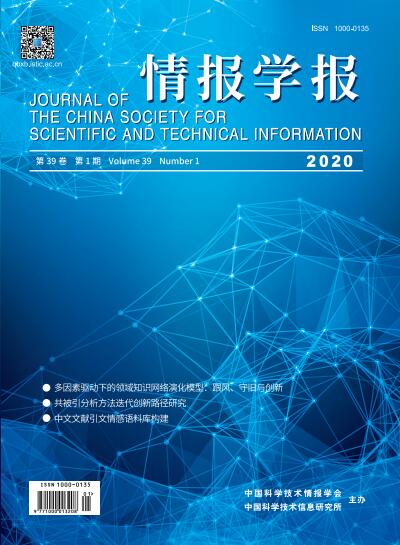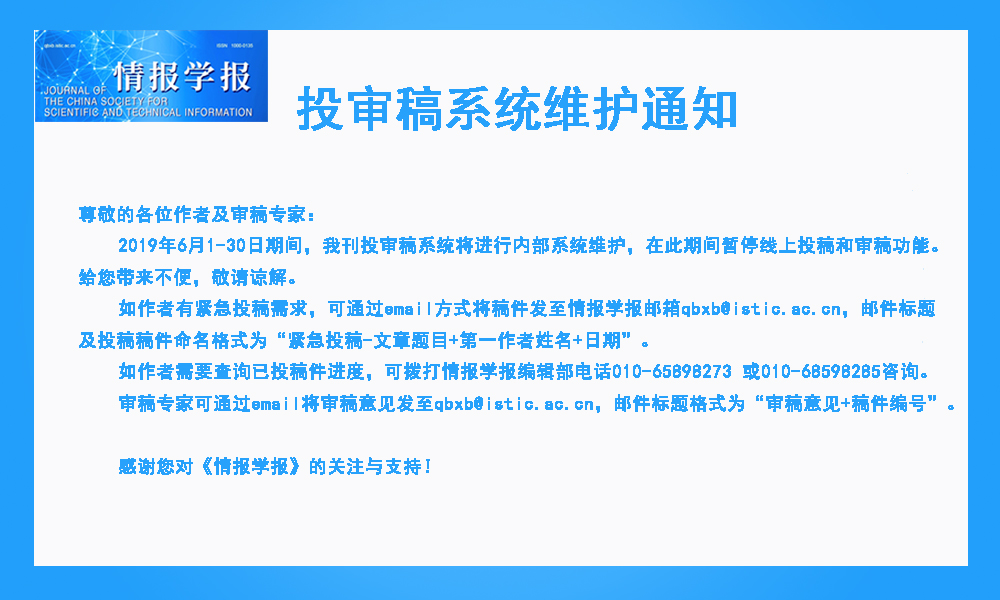 |
|
2020 Vol. 39, No. 1
Published: 2020-01-28 |
|
|
| |
|
|
|
|
|
1 |
A Network Evolution Model for Domain Knowledge Driven by Multiple Factors: Following Suit, Conservatism, and Innovation Hot! |
|
 |
Chen Guo, Zhao Yixin |
|
|
DOI: 10.3772/j.issn.1000-0135.2020.01.001 |
|
|
Current complex network models, such as Barabasi-Albert scale-free models and Watts-Strogatz small-world networks, cannot imitate many structural characteristics of the real domain knowledge network. Therefore, it is necessary to explore a new network model suitable for the evolution of domain knowledge. Based on the example of a keyword network, this study discusses the process of domain knowledge generation and its multiple influencing factors. The study then proposes a new network evolution model with keyword modules as basic units, which comprehensively considers following suit, conservatism, and innovation as influencing factors. A simulation experiment showed that the model was effective in fitting the structural characteristics of domain knowledge networks at both macro and micro levels. A further simulation experiment revealed the impacts of following suit and conservatism on growth of new knowledge and knowledge gathering. The proposed model could provide quantitative foundations for future studies on domain knowledge analysis. |
|
|
2020 Vol. 39 (1): 1-11
[Abstract]
(
371
)
HTML
(178 KB)
PDF
(1376 KB)
(
1173
) |
|
|
|
25 |
Corpus Construction for Citation Sentiment in Chinese Literature Hot! |
|
 |
Xu Linhong, Ding Kun, Chen Na, Li Bing |
|
|
DOI: 10.3772/j.issn.1000-0135.2020.01.003 |
|
|
A content-based citation sentiment analysis overcomes the traditional problem of frequency-based citation assimilation, which is an important research hotspot in the field of citation content analysis. However, citation sentiment analysis relies on annotated datasets, and the lack of a large-scale and high-quality citation sentiment corpus seriously restricts research progress in this field. Therefore, based on the analysis of citation sentiment expression, a set of annotation schemes for such expression is proposed in this paper, along with elaboration regarding the technology and method of corpus construction. A large-scale citation sentiment corpus on Chinese literature was constructed using the human-computer interaction annotation strategy through a comprehensive citation annotation system. The statistical results show the proportions of positive and negative citations as 22% and 6%, respectively, and the kappa value of citation sentiment reached 0.852, indicating that this corpus objectively reflects the author s sentiments and can provide data support for research in related fields such as paper evaluation, citation network analysis, and sentiment analysis. |
|
|
2020 Vol. 39 (1): 25-37
[Abstract]
(
480
)
HTML
(120 KB)
PDF
(3548 KB)
(
1262
) |
|
|
|
47 |
Awareness and Analysis of the Structure of the Information Synergy Network in China s Smart Government Hot! |
|
 |
Hu Mo, Ma Jie, Zhang Yunkai, Wu Bo |
|
|
DOI: 10.3772/j.issn.1000-0135.2020.01.005 |
|
|
Smart government is the next generation of e-government, which is an important issue for various countries. The efficiency of urban operation and management can be improved as a result of information synergy among various smart government departments. At present, research on intelligent government information synergy focuses mainly on its mechanism, and there are few studies regarding an awareness and analysis of the current structure of smart government information synergy networks. Based on relevant policy documents related to smart government as the target data sources, the method employed in this study was entity identification; the aim was to identify data of China s Smart Government Information Synergy Network and the synergistic relationship involving data of various government departments. Thus, the structure of this network can be acquired; subsequently, data can be visualized. On this basis, the degree centrality method (social network analysis) was adopted to rank each node according to its influence on the entire network. A k-plex analysis was used to identify the nodes that had a strong influence on the network. The results show that there are 34 nodes and 355 groups of nodes in China s Smart Government Information Synergy Network. Further, the State Council is the most influential node in the network, whereas the China Meteorological Administration is the least influential. The node relationship between the National Development and Reform Commission and the State Council has a strong influence on the entire network. In fact, there are 28 groups of node relationships with this type of strong influence. The results of this study can be used to guide the future direction of optimization and development of China s Smart Government Information Synergy Network. |
|
|
2020 Vol. 39 (1): 47-56
[Abstract]
(
281
)
HTML
(134 KB)
PDF
(4019 KB)
(
890
) |
|
|
|
57 |
Heterogeneous Information Network Embedding for Patent Technology Supply-Demand Trade Recommendations among Subjects Hot! |
|
 |
He Xijun, Dong Yanbo, Wu Yuying, Jiang Guorui, Ma Shan, Zheng Yao |
|
|
DOI: 10.3772/j.issn.1000-0135.2020.01.006 |
|
|
We constructed a heterogeneous information network (HIN) consisting of four types of nodes and ten types of relationships after considering the impact of seven parameters (technological proximity, geographical proximity, co-application relationship, citation relation, economic circle effect, subject type proximity, and subordinate relation among subjects) on trade. We then proposed heterogeneous relationship traversal algorithms based on the meta path and meta structure and obtained subject-relationship sequences based on multi-relational mapping. Based on the relation sequence corpus, we constructed a model of patent technology subject trade recommendations using network embedding (PSR-vec). We then trained the model using the Skip-Gram method of the Huffman tree to obtain a subject vector space representation. Finally, we calculated the similarity between subjectsvectors to formulate a trade recommendation. Through empirical research on patent data in the electronic information field from 2012 to 2018, we found that, first, with an accuracy rate of 82.4%, the PSR-vec model had greater accuracy compared to the DeepWalk, node2vec, and PathSim methods. Second, the recommendation accuracy of the combination of multiple meta paths and meta structures was higher than that of the single meta path or meta structure recommendation. Third, the accuracy of the recommendation results based on ρ2 and the meta structures S4, S6, S8, S10, S12, and S14 is higher than the accuracy of those based on ρ1 and improved meta-structures S3、S5、S7、S9、S11, and S13. This shows that the recommendation accuracy based on technological proximity among subjects is higher. Fourth, the recommendation accuracy is significantly improved for the meta structures with co-application, citation, subordinate relation, and economic circle effect on the basis of technological proximity, while the recommendation accuracy is lower when combining geographical proximity and subject type proximity. This indicates that geographical proximity and subject type proximity do not promote patent technology trade. Fifth, the recommendation subjects included the controlling relationship, the upstream and downstream relationship of the supply chain, and loosely related subjects, which reflected the validity and novelty of the recommendation results. This research provides a decision-making method for effective docking between subjects. |
|
|
2020 Vol. 39 (1): 57-67
[Abstract]
(
382
)
HTML
(248 KB)
PDF
(1325 KB)
(
1238
) |
|
|
|
90 |
Applied Research on Eye Tracking in Information Behavior Hot! |
|
 |
Li Jing, Chen Zhiyan, Chen Minghong |
|
|
DOI: 10.3772/j.issn.1000-0135.2020.01.009 |
|
|
The framework of this study is based on the integration of Wilson model and information journey model. The phases of determining demand, searching for information, judging and interpreting information, and using information are sequentially displayed to systematically present an overall view of the past ten years’ applications of eye-tracking experiment methods in the field of information behavior. The paper proposes that eye-tracking experiments are advantageous in researching aspects such as information behavior of vulnerable people, passive gaze, passive search behaviors, and information-avoidance behavior. After analyzing the drawbacks of the existing body of research, this paper proposes the following: (a) an expansion of applications for eye-tracking experiments; (b) standardizing the selection of and optimizing use of parameters; and (c) eliminating extraneous and unrelated factors as much as possible to create well-designed experiments that can be more easily replicated, shared, and referenced. This will contribute to the literature by providing enlightenment and promoting the application of the eye-tracking experiment method in the field of information behavior. |
|
|
2020 Vol. 39 (1): 90-99
[Abstract]
(
323
)
HTML
(128 KB)
PDF
(872 KB)
(
2308
) |
|
|
|
111 |
Exploration of Intellectual Structure and Hot Issues in Sentiment Analysis Research Hot! |
|
 |
Zhou Jian, Liu Yanbao, Liu Jiajia |
|
|
DOI: 10.3772/j.issn.1000-0135.2020.01.011 |
|
|
To comprehensively and systematically understand the development of affective analysis, this paper conducts bibliometric analysis and knowledge map analysis of affective analysis-themed literature included in the Web of Science with the help of software such as CiteSpace, UCINET, BICOMB, and SPSS. Using co-citation analysis, cluster analysis, co-word analysis, strategic coordinate analysis, and other methods, the knowledge structure, research foci, and trends in this field are revealed as follows: (i) The application of affective analysis, deep learning, and neural networks, product reviews of e-commerce, marking of emotional characteristics of things, user-generated content under social networks, semantic-oriented advertising technology, and textual language attribute analysis constitutes the knowledge structure of affective analysis. (ii) The researchers in this field focus on product comments and reputation, data mining and artificial intelligence, unsupervised learning, Hadoop-MapReduce and support vector machines, and neural networks and deep learning. (iii) Future research mainly includes customer reviews, recommendation systems, polarity classifications, subject models, movie reviews, and Twitter data. |
|
|
2020 Vol. 39 (1): 111-124
[Abstract]
(
665
)
HTML
(187 KB)
PDF
(2783 KB)
(
2643
) |
|
|
|


